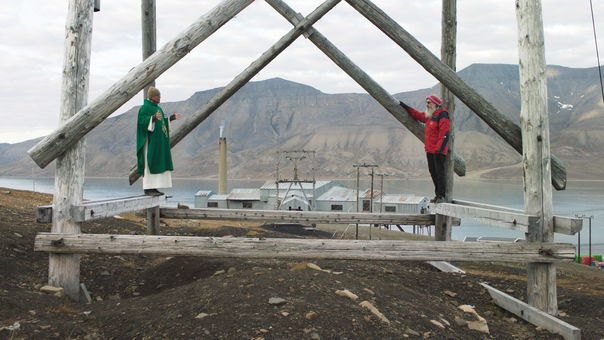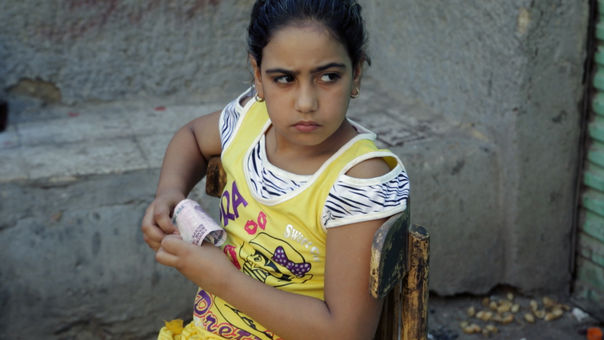Beyond the Frame: On the Phantom Presence of Documentarians Within Their Work
By Yasmine Zohdi

Wild Relatives
Artist, filmmaker and activist Jasmina Metwaly, whose solo exhibition WE ARE NOT WORRIED IN THE LEAST is currently showing at Savvy Contemporary as part of Berlinale Forum Expanded, spent years filming with the Mosireen Collective, an alternative media platform in Cairo, during the revolution and its aftermath. Members of the collective never put their names on their work, using pseudonyms instead. Metwaly’s show, however, appears to be an exercise of revealing, a clear departure from the anonymity that defined much of the collective’s work.
One installation, SIX LESSONS ON FILMMAKING, is particularly striking. In it, performance artist Alaa Abdullatif stands in for Metwaly, reading out texts that she wrote as guidelines for filming in certain situations. Although we can’t see the filmmaker herself, she is present through her words, and is unveiling the “secrets” of her craft to the viewer.
In one segment, Metwaly writes: “Know your camera well. If you can’t run with it, don’t bring it.” In another, she advises: “Keep the camera close to your body. Think of it as an extension to your limbs.” It is an intriguing juxtaposition, how the filmmaker, who often had to film under conditions where she and her camera had to be as invisible as possible, running from security forces on the streets during protests, uncovers how she did it. On a certain level, they are lessons on how to keep yourself “secret” as a filmmaker.
It is a position documentary filmmakers in particular often find themselves in, keeping their interventions hidden as they straddle the uncomfortable space between what’s real and their own perception of what they see. Documentarians are an active (if often invisible) participant in the scene with their subjects, often addressing them directly, guiding (even if unconsciously) their “real” actions, movements and words. This rich, complex dynamic takes place outside the frame, beyond the reach of the spectator – and so we are left to wonder, in an attempt to uncover the ultimate secret: Where does one reality end, and the documentarian’s begin?
In one scene of Reem Saleh’s WHAT COMES AROUND (Al Gami’ya, Egypt), which premiered in the Panorama section, a little girl called Dunia describes the process of undergoing FGM (female genital mutilation) in minute detail. Witty, forceful, and assertive, she in fact insisted on getting the operation, to prove that she is now a “young woman.” It is shocking to see her talk about it so casually, with a mixture of pride and humour, and shocking still to hear a few chuckles in the audience. The scene is indeed framed to be funny (for there is absolutely no other reason for it to be there in the film), and this is what makes it so unsettling.

The situation is made more mystifying by an argument over the operation that takes place between Dunia’s parents. As they fight, the mother visibly suppresses the urge to laugh, which makes me wonder whether this entire argument was feigned for dramatic effect. I can’t help but try and picture the director behind her camera: is she giving instructions beyond the frame?
WHAT COMES AROUND is intended to be a feel-good film. It is, after all, about a group of people banding together to form a credit union, overcoming hunger and severe financial need. There is of course, no space for a serious statement against FGM within such a narrative, for that would entail a profound confrontation with the meaning and consequences of poverty, the first of which would be ignorance. But in WHAT COMES AROUND, poverty is mere fact, and it is turned into a spectacle – one where Dunia is a central figure.
In filming social atrocities (like FGM), when does a documentarian stop being a mere chronicler and turn into an active participant? In the Q&A that followed the screening, Saleh – who we never see or hear throughout the film – says that she had spoken to Dunia’s parents, convincing them not to perform FGM on their daughter, and that she was rather “surprised” that Dunia ended up doing it anyway. Yet no one seems particularly upset about the choice – not Dunia, not her parents, not even Saleh.
“We are just filming life,” the Lebanese-Egyptian filmmaker says with a shrug, as though she really has no power over what unfolds on the screen. She says that sentence a few minutes after she admits that she had in fact filmed tons of footage that never made it into the film, including the characters’ involvement in the Egyptian revolution and its aftermath. She chose to cut it, she says, because “it had no effect on the characters’ lives.”
In WILD RELATIVES (Habb Barri, Lebanon), screening in this year’s Berlinale Forum section, director Jumana Manna’s presence is more pronounced, but somehow also more subtle, as it manifests in her choices as an author. The film follows the transfer of seeds cultivated in Lebanon’s Beqaa Valley to the Global Seed Vault in the Arctic Ocean island of Svalbard in what is part-investigative report, part-contemplation on climate change and the lasting effects of colonialism. It is also an unusual look at the repercussions of the war in Syria, represented in the group of refugee women working in the fields.
In an attempt to make its challenging subject more accessible, Manna explains the process herself, in sparse voiceover narration, directly addressing viewers. She intersperses the interviews that permeate the film with wide, picturesque shots of nature, both in the frosty Arctic and the dry Beqaa Valley, where the wheat stalks dance in the breeze. It is a clear intervention by the director to add a touch of poetry to an otherwise cerebral experience, speckled with technical information and laden with political undertones. These carefully composed frames add an extra layer to the film: it becomes a lamentation of our planet’s beauty, so intertwined with the environmental challenges that threaten it.
Manna’s presence is also evident in her treatment of a particular part of her subject: the women refugees, portrayed with a degree of intimacy absent from the film’s otherwise observational structure. “Do you know how to cook mulukhiyya?” We hear her ask one of them, and the girl laughs before describing how she makes the dish. It is an approach that translates in other scenes of the girls, where Manna shows them as they coyly smoke cigarettes and giggle, or dance in the fields while they work. Her affinity for them also comes across in how comfortable they are in the presence of her camera. But how spontaneous are these scenes?
As a filmmaker, Manna admits she stages some of her documentary work. There is no script, but she will tell the characters that they should discuss a particular topic, and leave them to improvise in their own words. When the moderator asks if the way two characters climb the scaffolding in a certain scene as they discuss the end of the world was planned beforehand, a small, mischievous smile plays on Manna’s face. “These are secrets,” she says.

